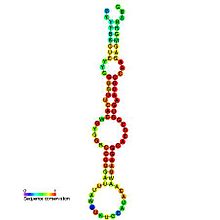mir-124 microRNA precursor family
| miR-124 microRNA precursor family | |
|---|---|
 Predicted secondary structure and sequence conservation of mir-124 | |
| Identifiers | |
| Symbol | mir-124 |
| Rfam | RF00239 |
| miRBase | MI0000443 |
| miRBase family | MIPF0000021 |
| Other data | |
| RNA type | Gene; miRNA |
| Domain(s) | Eukaryota |
| GO | GO:0035195 GO:0035068 |
| SO | SO:0001244 |
| PDB structures | PDBe |
The miR-124 microRNA precursor is a small non-coding RNA molecule that has been identified in flies (MI0000373),[1] nematode worms (MI0000302),[2] mouse (MI0000150) and human (MI0000443).[3] The mature ~21 nucleotide microRNAs are processed from hairpin precursor sequences by the Dicer enzyme, and in this case originates from the 3' arm. miR-124 has been found to be the most abundant microRNA expressed in neuronal cells. Experiments to alter expression of miR-124 in neural cells did not appear to affect differentiation.[4] However these results are controversial since other reports have described a role for miR-124 during neuronal differentiation.[5]
Targets of miR-124
- Visvanathan et al.. showed that miR-124 targets the mRNA of the anti-neural function protein SCP1 (small C-terminal domain phosphatase 1).[6]
- Makeyev et al. showed that miR-124 directly targets PTBP1 (PTB/hnRNP I) mRNA, which encodes a global repressor of alternative pre-mRNA splicing in non-neuronal cells.[7]
References
- ^ Lai, EC; Tomancak P; Williams RW; Rubin GM (2003). "Computational identification of Drosophila microRNA genes". Genome Biol. 4 (7): R42–. doi:10.1186/gb-2003-4-7-r42. PMC 193629. PMID 12844358.
{{cite journal}}: CS1 maint: extra punctuation (link) CS1 maint: unflagged free DOI (link) - ^ Lim, LP; Lau NC; Weinstein EG; Abdelhakim A; Yekta S; Rhoades MW; Burge CB; Bartel DP (2003). "The microRNAs of Caenorhabditis elegans". Genes Dev. 17 (8): 991–1008. doi:10.1101/gad.1074403. PMC 196042. PMID 12672692.
- ^ Lagos-Quintana, M; Rauhut R; Yalcin A; Meyer J; Lendeckel W; Tuschl T (2002). "Identification of tissue-specific microRNAs from mouse". Curr Biol. 12 (9): 735–739. doi:10.1016/S0960-9822(02)00809-6. PMID 12007417.
- ^ Cao X, Pfaff SL, Gage FH (2007). "A functional study of miR-124 in the developing neural tube". Genes Dev. 21 (5): 531–6. doi:10.1101/gad.1519207. PMC 1820895. PMID 17344415.
{{cite journal}}: CS1 maint: multiple names: authors list (link) - ^ Yoo AS, Staahl BT, Chen L, Crabtree GR (2009). "MicroRNA-mediated switching of chromatin-remodelling complexes in neural development". Nature. 460 (7255): 642–6. doi:10.1038/nature08139. PMC 2921580. PMID 19561591.
{{cite journal}}: CS1 maint: multiple names: authors list (link) - ^ Visvanathan J, Lee S, Lee B, Lee JW, Lee SK (2007). "The microRNA miR-124 antagonizes the anti-neural REST/SCP1 pathway during embryonic CNS development". Genes Dev. 21 (7): 744–9. doi:10.1101/gad.1519107. PMC 1838526. PMID 17403776.
{{cite journal}}: CS1 maint: multiple names: authors list (link) - ^ Makeyev EV, Zhang J, Carrasco MA, Maniatis T (August 2007). "The MicroRNA miR-124 Promotes Neuronal Differentiation by Triggering Brain-Specific Alternative Pre-mRNA Splicing". Mol. Cell. 27 (3): 435–48. doi:10.1016/j.molcel.2007.07.015. PMC 3139456. PMID 17679093.
{{cite journal}}: CS1 maint: multiple names: authors list (link)
External links
